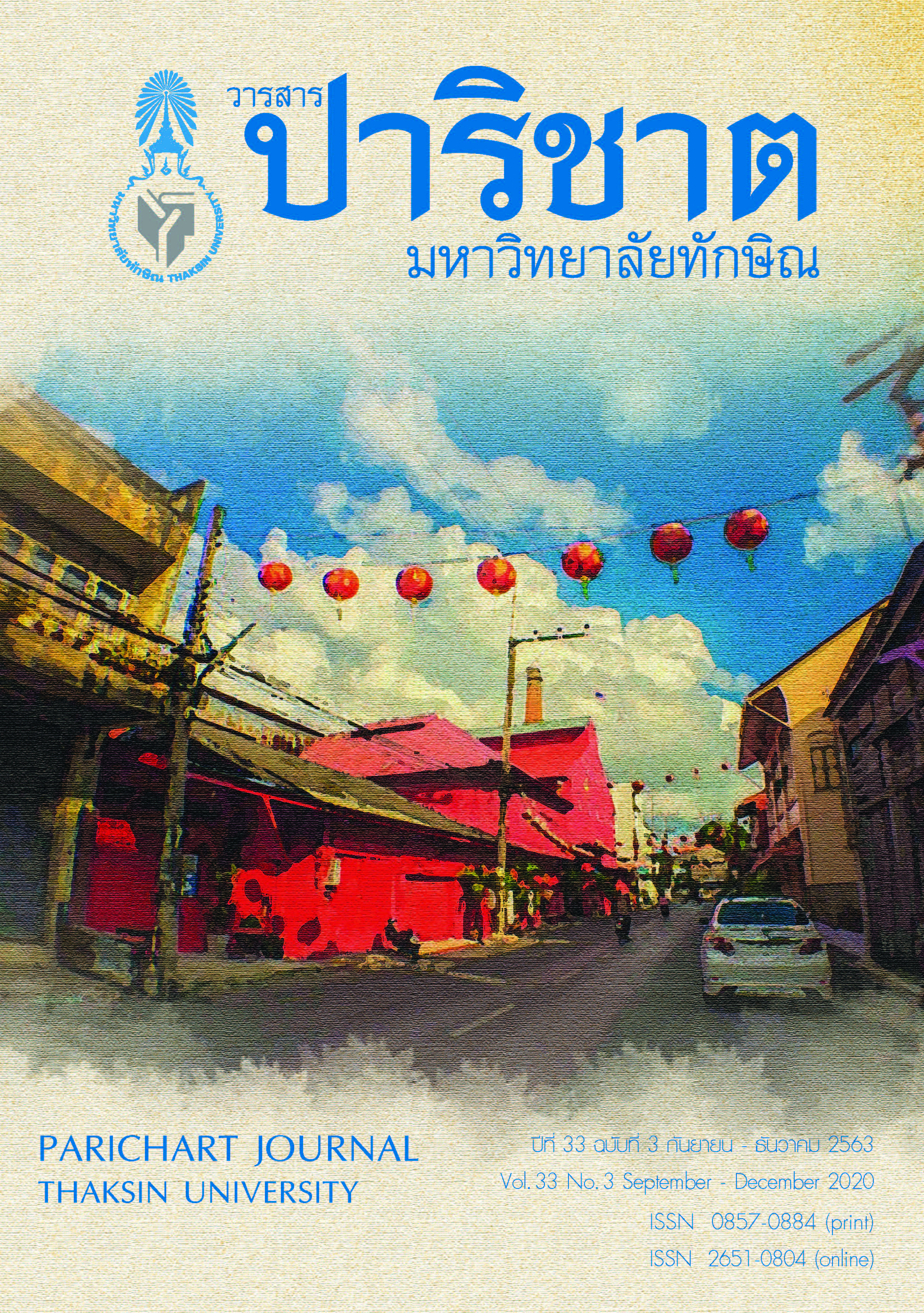Diversity of Community Cultural Heritage in Muang Takua Pa Municipality, Phang Nga Province, to Upgrade the Guidelines of Tourism Management
Main Article Content
Abstract
This article presents a study of the cultural heritage and proposes guidelines for tourism management in the Takua Pa municipality area, Phang Nga province. Two communities, namely, Talat Yai Community and Senanuch Rangsan Community, were selected for data collection using qualitative research methods. An in-depth interview was held with 12 participants and a focus group discussion was organized with 5 articipants. In addition, non-participant observation was also conducted. The data were analyzed, categorized, and interpreted. The results were summarized using descriptive stastistics. The research results are as follows. 1) diversity of cultural heritage is divided into tangible and intangible forms. It is related to ethnic groups and the former prosperity of mining resulting in the existence of a way of life in terms of architecture, temple, dress, tradition, festivals, etc. The distinctive characteristics of historical places through the transfer of thinking skills are passed on from generation to generation through the spirit of the community. 2) the interaction of local people in the community and their appreciation of the community history lead to ideas for managing cultural heritage sites through the design of tourism guidelines in which the past constitutes an element of the design of tourism program activities to promote the creative economy for the community and appropriate technology is used for the sustainable storage of cultural heritage in the area.
Article Details
References
Nagy, K. (2012). Heritage tourism, thematic routes and possibilities for innovation. Club of Economics in Miskolc’ TMP, 8(1), 46-53.
Swarbrooke, J. (1998). Sustainable tourism management. New York: CABI.
UNESCO. (1972). Convention concerning the protection of worldcultural and natural heritage. Paris: UNESCO. [Online]. Retrieved May 22, 2019, from https://whc.unesco.org/archive/convention-en.pdf.
UNESCO. (2003). Convention for safeguarding of intangible cultural heritage. Paris: United Nations Educational, Scientific and Cultural Organization (UNESCO).
ICOMOS Thailand. (2011). Thailand charter on cultural heritage sites management. Bangkok .ICOMOS Thailand. (In Thai)
Feilden, B. M., & Jokilehto, J. (1998). Management guidelines for world cultural heritage sites. Rome: ICCROM.
Saengna, C. (2011). Protection of underwater cultural heritage in the specific economic zones and shoulders The continents of Thailand. Master of Laws Degree, Ramkhamhaeng University, Bangkok. (In Thai)
Ito, N. (2003). Intangible cultural heritage involved in tangible cultural heritage. Retrieved from http://www.international.icomos.org/victoriafalls2003/papers/.
Lertcharnrit, T. (2016). Cultural resource management. Sirindhorn Anthropology. Center, 2nd edition. Bangkok: Sirindhorn Anthropology Center. (In Thai)
Ji, L. (2020). Community participation in cultural heritage management: A systematic literature review comparing Chinese and international practices. Cities. 96(2020).
Mowforth, M., & Munt, I. (2016). Tourism and sustainability. New York: Routledge.
Suansri, P. (2011). CBT has a social space dimension of the community in determining tourism direction, creating learning among homeowners and visitors. Bangkok: The Thailand Research Fund. (In Thai)
Giampiccoli, A. (2015). Community-based tourism: origins and present trends. African Journal for Physical, Health Education, Recreation and Dance, 21(2). 675-687.
Boonwanno, S., Boonprakarn, K. & Dhammasaccakarn, W. (2018). Nostalgia and commoditization in tourism dimension of Thai society. Social Sciences Research and Academic Journal. 39(13), 1-14. (In Thai)
Boonwanno, S. (2016). Old town Takuapa: From area to commoditization in tourism. (Master of Arts Human and Social Development). Prince of Songkla University, Songkhla. (In Thai)
Kirdsiri, K., Buranaut, I., & Seneevong Na Ayudhaya, K. (2016). Status assessment of sites in Thailand on the world heritage tentative list: Prospects of being placed on the world heritage list. NAJUA: Architecture, Design and Built Environment, 30, 61-75. (In Thai)
Designated Areas for Sustainable Tourism. (2020). Definition of Creative tourism. Retrieved from http://www.dasta.or.th/creativetourism/th/ (In Thai)
Nurick, J. (2000). Heritage and tourism. Locum Destination Review, 2, 35-38.
Fladmark, J. M. (1994). Cultural tourism, papers presented at the Robert Gordon University Heritage Convention, Conference proceedings book, Donhead Publishing, London.
Charoenkitpaisal, P. (2010). The study of mon community cultural tourism resources to develop ecotourism in pathumthani Province. (Master of Science Degree in Ecotourism Planning and Management). Srinakharinwirot University, Bangkok. (In Thai)
Nuryanti, W. (1996). Heritage and Postmodern. Tourism, annals of tourism research, 23(2), 249-260.


